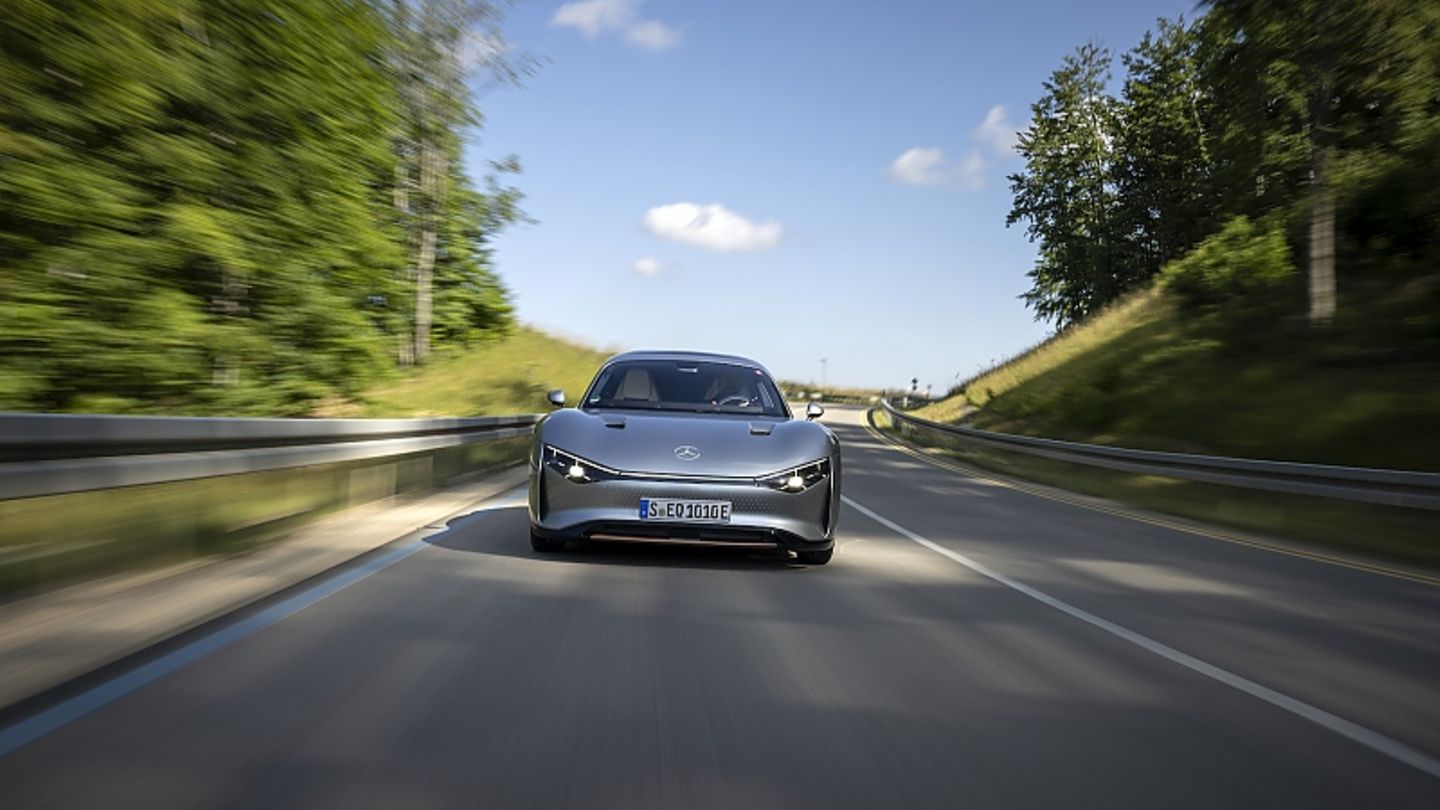The electric flounder of the Mercedes EQXX has already set two records in its short lifetime. With one battery charge, the Swabian electric model initially managed 1,008 kilometers and then 1,202 kilometers on the second attempt. But how does the technical forerunner of the upcoming entry-level models with the star actually drive when there is no Mercedes test driver behind the wheel?
Mercedes made a lot of noise about the one-off Vision EQXX. There is a good reason for this, because the EQXX is the technical forerunner of the new entry-level series with the star, which is scheduled to come onto the market in 2024/2025. It is intended to replace models such as the current Mercedes A-Class or the CLA, which is currently available as a sedan and shooting brake, as an electrifying shoehorn in the newly proclaimed luxury strategy. The study of the Mercedes Vision EQXX, in which we took a seat and drove a few kilometers, shows where this journey should go in the second half of the decade. Unfortunately not under real conditions on public roads, as the development team did on two long-distance drives from Stuttgart to Cassis in southern France and later again from Stuttgart to Silverstone in the UK. Here, the electric flounder initially managed just over 1,000 kilometers and on the second attempt just over 1,200 kilometers.
This time Julien Pillas, the developer responsible for special e-drive projects, only sits in the passenger seat and makes sure that nothing goes wrong with the test subject, who is worth millions, even if we are only on the Mercedes test site in Immendingen. Open the door, get in and first of all wonder how uncomfortable the bright leatherette seats are for a tall adult. Julien Pillas has sat endless miles in the EQXX and so he has to chuckle when he hears the early complaint about the moderately padded seats lacking long-distance comfort. Even if the EQXX is an extremely chic four-door coupe sedan with too much rose gold, there is not much luxury inside. The seats are hard, offer just as little lateral support as support and can only be adjusted mechanically – okay, just a prototype – but at least a cool one. There is definitely more comfort in the upcoming A-Class and the at least three other derivatives – customers can look forward to that. But the powerful screen with a diagonal of impressive 47 inches is more impressive than ever – flat and wide from A-pillar to A-pillar. The upcoming compact models should also get a powerful broadband screen that says goodbye to the postcard design of the current models.
But the drive is more important. The EQXX is powered by an electric motor on the rear axle, which has an output of 180 kW / 245 hp and is therefore properly motorized. This electric motor is powered by a particularly flat battery pack, which is only half the size of that of the Mercedes EQS luxury model and still has an impressive 100 kWh of power. One step on the gas and off you go. After just a few hundred meters, it becomes clear that everything here is trimmed for efficiency, because with a drag coefficient of 0.17, the four-seater, weighing 1,755 kilograms, literally hisses under the headwind. The narrow 185 tires are special tires that are inflated to a full 3.5 bar – their ride comfort is correspondingly moderate. But in the end it’s all about covering as many kilometers as possible with as little energy as possible, and the thin cutting discs on the axles are already familiar from the BMW i3 economy car, which has now been discontinued.
Apart from the hard seats, the EQXX doesn’t drive like a prototype, but almost like a real production model – at least if you ignore the slight creaking noises of the side windows. Recuperation can be adjusted using the shift pedals on the steering wheel. In the strongest level you are on the road with the so-called one-pedal driving experience with maximum deceleration and correspondingly high efficiency. Braking is practically only in an emergency. It was the same with the first record run. “Here we only pressed the brake pedal a couple of times during the entire journey,” remembers Julien Pillas of the 1,000 km tour a few weeks back south.
The steering is smooth, the electric motor in the rear is quiet, and so it is on the country roads on the Mercedes test site, which can be driven on quickly, which were once a strictly secured military training area for the German Armed Forces. After extensive conversion work, there are roads from all over the world here in order to be able to adapt the prototypes to international conditions as much as possible with minimal effort during the several years of testing. The battery pack, weighing 495 kilograms, is flat, but the seating position is slightly higher than in the current A-Class or a CLA with a combustion engine. Information about speed, consumption and whatever else flickers on the mighty screen. It can be specially dimmed so that it does not use too much electricity, because every microwatt counts. Julien Pillas looks at the real-time consumption values and seems satisfied.
The second hill is a brisk climb and even the winding country road, which is supposed to resemble a rough US road surface, doesn’t cause any trouble for the driver and EQXX. On the outside of the test oval, it’s a longer stretch straight ahead, slightly downhill. “Just let it roll – the EQXX is really impressive,” says test driver Julien Pillas and you can only agree with him. Without recuperation, the future model seems to be able to roll almost to the end of the world, where there seems to be little resistance. You are slowed down all too early by the next roundabout and the way back to the starting point. Without a particularly cautious driving style, the Mercedes EQXX consumed just 8.24 kWh / 100 kilometers over a distance of 16.2 kilometers; a value to be proud of. Especially at a speed of almost 50 km/h.
The batteries of the future small series models will not be as lavishly dimensioned as in the EQXX prototype, but should be around half the size. The on-board voltage of 900 volts should be set, as well as the secret cell chemistry, which should be enough for a range of at least 500 kilometers. The energy density is more than 400 wh/l and is therefore higher than in the EQS. One reason for this is the anodes with their high silicon content, in contrast to the graphite anode of the EQS. The battery is so efficient that it only has to be cooled by the airstream and therefore does not need its own cooling circuit. “The technology program behind the Vision EQXX will redefine and enable future models and vehicle functions from Mercedes-Benz,” emphasizes Mercedes Board Member for Development Markus Schäfer.
Source: Stern
I am a 24-year-old writer and journalist who has been working in the news industry for the past two years. I write primarily about market news, so if you’re looking for insights into what’s going on in the stock market or economic indicators, you’ve come to the right place. I also dabble in writing articles on lifestyle trends and pop culture news.




